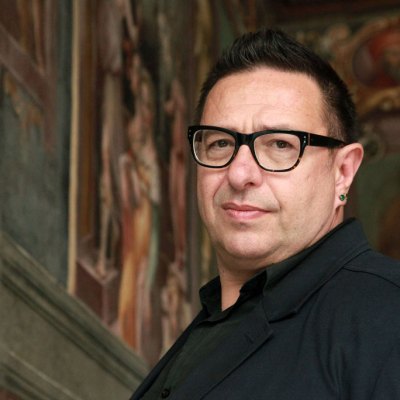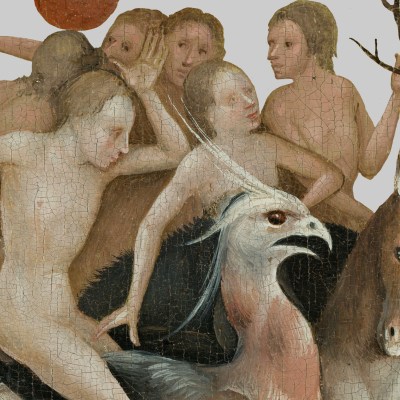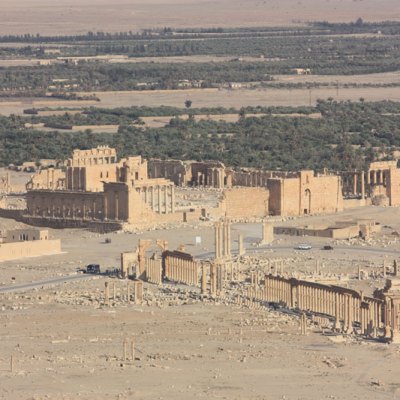The artist Jannis Kounellis has died in Rome at the age of 80. Kounellis was born in Greece in 1936 but moved to Italy at the age of 20 to study at the Accademia di Belle Arti. He would go on to become one of the leading figures of the Arte Povera movement, making works in a vast range of materials, from burlap sacks to coal, and perhaps most famously by installing 12 horses in Galleria L’Attico in Rome in 1969. Last April, as an exhibition of his work went on display at the Monnaie de Paris, he talked to Martin Gayford for Apollo. The full text of the interview is reproduced below.
A few months ago, the Greek artist Jannis Kounellis (b. 1936) was in Sicily, talking to the students of the Accademia di Belle Arti in Palermo. It was, he recalls, just after a great many drowned bodies of refugees had been found floating in the sea. ‘I found myself thinking about Piet Mondrian. I imagined him there in Sicily today, sitting in a studio confronted by this terrifying spectacle. Under those circumstances, Mondrian wouldn’t have been able just to paint a vertical line and a horizontal one – that wouldn’t have been enough.’
This juxtaposition of a hero of 20th-century abstraction and a refugee crisis in the early 21st century is a poetic metaphor, which is typical of Kounellis. On the one side there is the radical, avant-garde figure dedicated to the creation of new forms of art; on the other suffering, death, and disaster. A great deal of Kounellis’s art consists of combining and contrasting art and reality. Then there is the setting, the Mediterranean. Kounellis is first and foremost a Mediterranean man for whom, I can’t help feeling, the waters in which the boats from Libya and Syria are capsizing is still Homer’s wine-dark sea.
In 2002 he created an installation at the Galleria Nazionale d’Arte Moderna in Rome that consisted of a labyrinth, resembling, as he put it, ‘an octopus’. Both motifs go back to Minoan Crete where, according to legend, the Minotaur lived in a subterranean maze and octopuses were common decorations on pottery. The art historian Stephen Bann described the works as a ‘homecoming’ for Kounellis: ‘The works […] that greeted visitors in their passage through the labyrinth seemed to emanate not just from his own history, but from a collective history of the Roman and Mediterranean world.’ Those visitors, however, would have also encountered a huge assortment of items that would not have seemed particularly classical, such as bedsteads, coal, burlap sacks, old clothes, and iron plates. And, as Bann puts it, over time the art of Kounellis has been ‘characterised by an extraordinary, indeed bewildering, variety of materials comprising vegetable and mineral, the natural and artificial, the dead and alive’.
Installation view of ‘BRUT(E)’ at the Monnaie de Paris, 2016. Courtesy Monnaie de Paris; photo: Manolis Baboussis; © Jannis Kounellis

Some artists of the loose grouping known as Arte Povera have tended towards a signature element – mirrors for Michelangelo Pistoletto, trees for Giuseppe Penone, for example. In contrast, the ingredients of Kounellis’s work bring to mind the contents of a Renaissance chamber of curiosities. It’s difficult to think of a substance or category of thing he hasn’t used. In the late 1960s and early ’70s, he produced works that incorporated, among other items, a parrot, tablets of burning fuel, live birds in cages functioning as picture frames, and a violinist and a ballerina.
‘I don’t have a rigid repertoire,’ he tells me when we meet in the elegant 18th-century rooms of the Monnaie de Paris where he is about to begin installing works for an exhibition, titled ‘BRUT(E)’. The works shown here are a response to the Paris Mint, which has been striking coins and medals since 1864, but also contain earlier pieces. As always, Kounellis takes a particular place and its history as his starting point. ‘I don’t know why, but I’ve always been inquisitive,’ he says. ‘I just accept what emerges, also from literature. For example, I feel a great affinity for Victor Hugo and his comprehension of the underworld of suffering. This suffering society is still mine. I have often used an iron bedstead, two metres long and 82 centimetres wide, which is more or less the size of a peasant’s bed. It’s a constant reminder of humanity.’ There are reasons why the author of Les Miserables and the Hunchback of Notre Dame might come to Kounellis’s mind. We are, after all, sitting within sight of the Seine and not far from the cathedral on the opposite bank of the river. And while the form of Kounellis’s work may be radical, it has links with European culture running far back into the past.
In 1969, at the Galleria L’Attico in Rome, he created one of the most sensational exhibitions in 20th-century art when he displayed a work in which 12 live horses were tethered to the sides of the room. This, on the face of it, was a long way from Mondrian, and indeed from anything that had previously counted as art. Kounellis explains that it was almost a formal idea.‘What interested me,’ he says, ‘was that the horse was part of the wall.’ That is, the way the horses marked out the architectural contours of the space.
Installation view at Gavin Brown’s Enterprise, New York, 2015, of Untitled (12 horses), first shown in 1969 and featuring 12 live horses. Courtesy Gavin Brown’s Enterprise, New York/Rome and Cheim & Reid; photo: Brian Buckley; © Jannis Kounellis

Like a great deal of what Kounellis says, this is not so gnomic and surprising when you think about it. Art – especially Western art – is full of examples of horses marking out the perimeters of buildings in just this way: think of the Parthenon frieze or the façade of San Marco. The difference, and it’s an extraordinary shift, is that Kounellis used real ones (and consequently ran into protests from animal-rights activists when the piece was recreated at Gavin Brown’s Enterprise in New York last year). Kounellis explains, ‘Obviously, I just put them there: creatures that had a weight and a natural personality, animals that breathed and moved. So it was different from classical iconography. On the other hand, it is true that there is a certain classicism about this work. It isn’t a Pop art image. It was calculated and came out of living in this city that has an incredible history underneath it. It was modern but not modernist, and modern despite being ancient.’
It is now 60 years since Kounellis moved to Rome, a city whose nodal point, the Campidoglio, is marked by the magnificent bronze horse ridden by the emperor Marcus Aurelius. Kounellis’s location in Rome is one of the distinctions between him and other members of the Arte Povera movement such as Luciano Fabro, Mario Merz, Pistoletto, and Penone, who were, or are, based in the north, in Turin and Milan. Italy, Kounellis points out to me, is not a country with a single dominant cultural metropolis, like Britain or France. When I ask about the Italian art scene of the 1950s and ’60s, he quickly observes, ‘Italy is made up of several centres. There was an enormous amount of cultural activity then. It was surprising to me when I first arrived.’
As Kounellis talks, there are hints of the way the city has entered into his imagination. In a discussion with the critic Michele Robecchi about the importance of drama in Italian culture, he has cited the example of Caravaggio – one of the most powerful visual presences in Rome, since half a dozen of his greatest masterpieces are scattered through churches in the centre of the city. He offers me another quintessentially Roman example to make a similar point. ‘What’s happening in the Laocoön is very dramatic, isn’t it?’ Indeed, it is: a massively muscular naked man and his two sons are struggling desperately against deadly serpents. This too might be described as a ‘terrifying spectacle’. Drama is fundamental to Kounellis’s work. ‘If you take drama away from form you are left with formalism,’ he explains. ‘Without drama, art becomes merely an industrial affair.’ By which he means, no doubt, just a matter of manufacturing objects. ‘Western thought gives human beings a central role. Everything needs to be centred on humanity, otherwise there’s a great risk of falling into decadence.’
‘Arte Povera was a term born in the theatre,’ Kounellis says, ‘that’s one reason I recognised myself in it. The phrase is connected with [Jerzy] Grotowski’s idea of a teatro povero.’ In the early 1960s, the experimental Polish director expounded on the concept of a ‘poor theatre in which the relationship between actors and audience was primary, rather than sets and props. It inspired the Italian critic Germano Celant to come up with the term Arte Povera to describe the work of a number of young artists, including Kounellis, many of whom were included in an exhibition at the Galleria La Bertesca in Genoa in 1967.
This element of drama or theatricality, to Kounellis’s mind, is what separates him and his European contemporaries from American minimalists such as Donald Judd or Carl Andre. ‘It is clear that minimalist art has a very different emotional effect. The minimalist point of reference was linked to a Protestant civilisation. For those Americans, drama was démodé. The minimalists didn’t want to have anything to do with images, but my work can be connected to a painting such as Van Gogh’s Potato Eaters (1885). There are various ways to be modern, and various ways of seeing in modernism.’
Installation view of ‘BRUT(E)’ at the Monnaie de Paris, 2016. Courtesy Monnaie de Paris; photo: Manolis Baboussis; © Jannis Kounellis
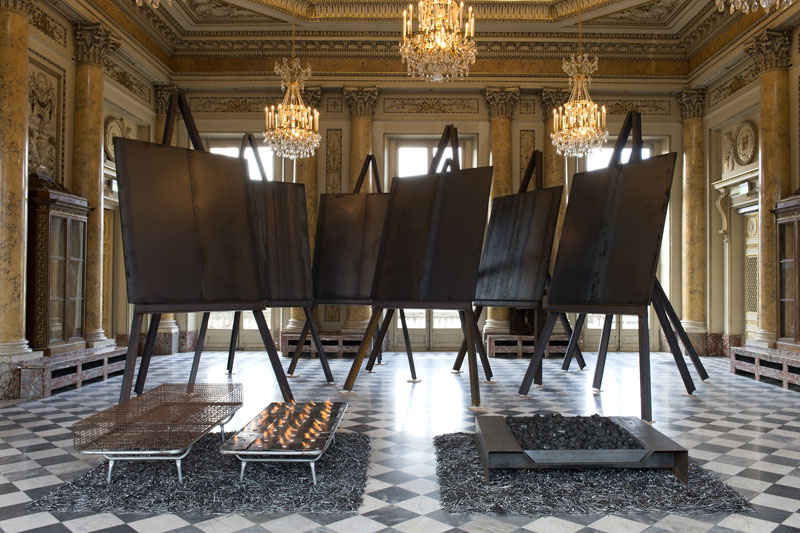
This reference to Van Gogh, like the ones to Victor Hugo and ancient Rome is crucial to an understanding of Kounellis’s work. There is a sense in which Kounellis the artist begins with Vincent Van Gogh. ‘You can’t say exactly when for the first time it was that I got interested in painting or images, precisely when it was – some particular morning or afternoon. But one day lost in time, at a certain hour, you understand that painting is everything.’ His childhood friend, the late Yannis Sakellarakis, has recalled having endless discussions with the teenage Kounellis about Van Gogh: ‘He was obsessed by the painter’s loneliness and agony.’
Kounellis was born in Piraeus in 1936, and grew up in the busy port of Athens. The sacks full of commodities such as beans and coffee that were included in some of his early works have been linked to the cargoes of the ships that docked in the harbour. His childhood and adolescence spanned the Second World War and the savage civil war that followed. ‘The city I knew was post-war, and in Greece that was a dramatic time, not only during the war but also afterwards.’ Somehow in this environment the young Kounellis conceived the ambition to become an artist.
It was an Old Master, Kounellis tells me, who lured him across the Adriatic. ‘I came to Italy because I was interested in painters such as Masaccio – a revolutionary artist [who] changed from the idiom of the Middle Ages. He was not only a great painter, but also had a great intuition. His art was not classical, but humanistic. And I was born in the country that invented humanism.’ It is not too hard to see the links between Kounellis’s art and Van Gogh’s Potato Eaters or Masaccio’s Brancacci Chapel frescoes, depicting intensely solid and real human beings and simple, straightforward objects.
Although it is a long time since Kounellis has exhibited anything resembling a conventional painting, he still describes himself not as an installation artist or sculptor, but as a painter. ‘I have the mindset of a painter. That’s my identity. I couldn’t abandon that even if I wanted to. In Greek the word for painter is zōgraphos, which means someone who draws life. The Greek is much more precise. It’s a matter of living experience.’
Installation view of ‘BRUT(E)’ at the Monnaie de Paris, 2016. Courtesy Monnaie de Paris; photo: Manolis Baboussis; © Jannis Kounellis
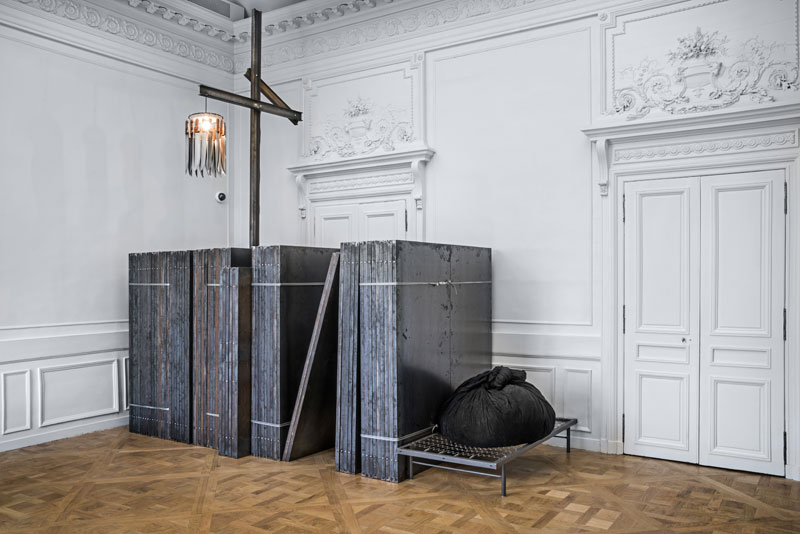
In Rome he quickly encountered a range of new experiences and influences. ‘For painters, [the city] was a compost, [which allowed you to be] a citizen of a certain nation and [experience] currents of international activity. There was also the cinema. Neorealist films defined something that was not at all rhetorical. Italy was then a country that was living through the aftermath of a tragic war, but that didn’t prevent these filmmakers from having a vision of Italian reality. This gave me courage.’
Kounellis has acknowledged the importance to him of avant-garde painters such as Lucio Fontana, who cut through his canvases into real space, and Alberto Burri, who sewed together burlap sacking to make his pictures (rather as Kounellis later used the sacks on their own). His points of references were not only Italian. ‘The director of the Galleria d’Arte Moderna in Rome was Signora Bucarelli, who was an extraordinary personality. In 1958 she put on an exhibition of Jackson Pollock, the first big one in Italy. It was a revelation to me. In Pollock’s work you could intuit the drama. That gives a great mobility to form, and in Pollock’s work you can see it.’
Installation view of ‘BRUT(E)’ at the Monnaie de Paris, 2016. Courtesy Monnaie de Paris; photo: Manolis Baboussis; © Jannis Kounellis
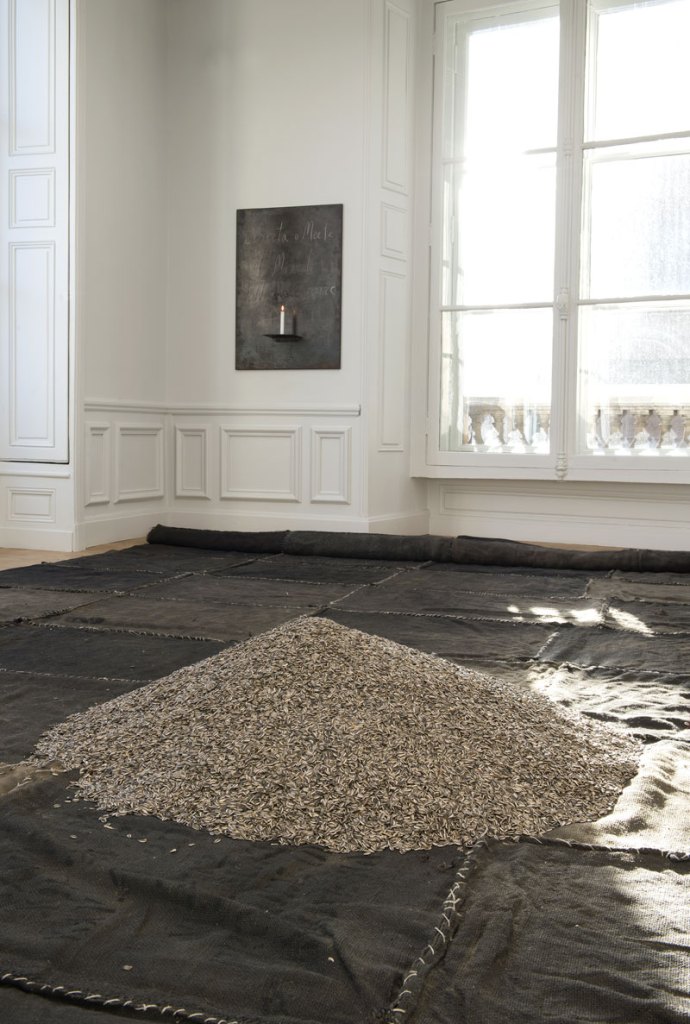
‘My tutor at the Accademia di Belle Arti was Toti Scialoja, a man who was acute, a heavyweight who had spent time in America.’ (Scialoja was a poet of note as well as an artist, and a friend of Mark Rothko and Willem de Kooning, among others.) Kounellis continues: ‘It was Scialoja who introduced me to the Galleria La Tartaruga, a centre at that time, where I had my first exhibition in 1960 when I was still a student at the Accademia. I was very young.’ This first exhibition was of paintings featuring letters and numbers, painted on wet canvas suspended on the walls of Kounellis’s studio.
The execution of these early pictures was already a sort of performance or, as Kounellis prefers to put it, drama. ‘I would put them on the walls, and paint something on them; at the same time I would sing. It was the period of Hermetic poetry (Ermetismo in Italian), which I liked, although it was far from realism. There was an extraordinary Hermetic poet, Giuseppe Ungaretti.’ Giuseppe Ungaretti, with Eugenio Montale, is the most celebrated of 20th-century Italian poets. He wrote many of his best-known poems while serving on the Alpine front during the First World War, but they lack the anger and outrage of British writers such as Wilfred Owen. Instead, Ungaretti’s poems are pared down and concrete. One of the most famous, ‘Mattina’, consists of just four words: ‘M’illumino / d’immenso’ (I illuminate myself / with immensity).
In the course of the 1960s, Kounellis moved away from these poem-paintings towards making images with real things and living organisms in real space. ‘I changed when I understood that there was a risk of my painting just becoming a style. So I moved slowly towards the exit. Obviously, someone who was making hermetic poetry on a sheet hung on the wall was going to become a member of Arte Povera.’
There is a touch of alchemy in Kounellis’s art. He puts objects in a space, carefully arranged in a rhythm because as he has pointed out space always needs to be articulated rhythmically – as in a Pollock drip painting or by those horses spaced out around the walls. At a certain moment, if you are a believer, it turns into art – a transformation that Kounellis likes to describe with a Greek word: metamorphosis. How does he know it has occurred? ‘The work is finished,’ he declares, ‘when the paroxysm arrives.’
Jannis Kounellis photographed at the Monnaie de Paris, March 2016. Courtesy Monnaie de Paris; photo: Manolis Baboussis; © Jannis Kounellis

This article first appeared in the April 2016 issue of Apollo.

